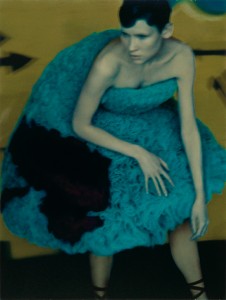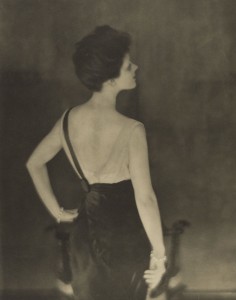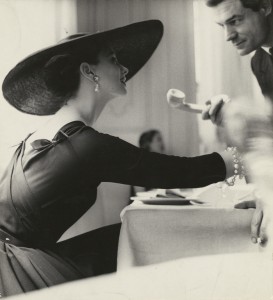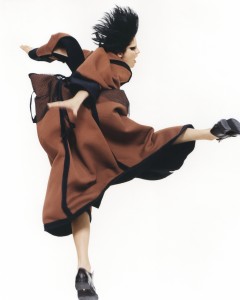Cultural Cocktail Hour
A FOR ART- Icons of Style- A Century of Fashion Photography- A MUST SEE at the Getty Center
A for Art
ICONS OF STYLE: A CENTURY OF FASHION PHOTOGRAPHY- A MUST SEE AT THE GETTY CENTER
By
Leticia Marie Sanchez
June 26–October 21, 2018
Icons of Style at the Getty is NOT-TO-BE MISSED for a myriad of reasons.
Firstly, the presentation itself is visually compelling. Iconographic fashion photography surround dynamic costumes ranging from Coco Chanel, Christian Dior, Madeleine Vionnet, Madame Grès, Issey Miyake, and Alexander McQueen.
Secondly, and more importantly, this exhibit is the first of its kind.

Photo Left: Sarah Moon, 1941, Sveta for Hussein Chalayan, 2000; Carbon print; 2011.52; 57.2 × 43.4 cm (22 1/2 × 17 1/16 in.) Copyright:© Sarah Moon
Historically, museums have not actively collected fashion photography because the medium has been viewed as undeserving of the capital letter A for Art bestowed upon portraiture, landscape, and abstraction. Even within the genre of photography itself, fashion photography has often been deemed second rate. Although MOMA established a curatorial department dedicated to photography in 1940, a clear hierarchy conferred higher status to black and white fine art photographs over photographs created for commercial purposes like fashion photography.
The exhibit at the Getty, therefore, is a watershed moment for fashion photography.
In 2010, Curator Paul Martineau began working to augment the museums collection in this genre, and with the museum added seventy photographs by 25 makers to the permanent collection.Icons of Style showcases the work of more than 80 photographers, illustrating stylistic and technological evolutions. In the accompanying cataloguePaul Martineau explains that, “few museums have dedicated the time and resources necessary to pursue fashion photography in such a strategic and committed manner.”

In addition to the works held by the Getty, lenders to the exhibition include: the Metropolitan Museum of Art, the Museum of Fine Arts, Boston, and the Victoria and Albert Museum, London. LACMA provided costumes by designers from Gabrielle “Coco” Chanel to Alexander McQueen.
Photo Left: House of Dior, Christian Dior, Women’s Dress “Abandon” Fall/Winter 1948;© Los Angeles Museum of Art, Museum Associates, LACMA
So, what distinguishes a simple fashion advertisement to a work deemed worthy for the hallowed halls of a museum? In his introduction to the exhibit catalogue, Paul Martineau reveals his litmus test of what elevates a work to the capital A of Art.” At least part of the answer lies in the ability of a fashion photograph to be a reflection of two or more worlds: the perfect world inside the frame- the place where youth, beauty, and luxury reign supreme- and the harsh realities of the world outside it. The best fashion photographs can remind us of other works of art or expand the boundaries of the genre, redefining what a fashion photograph is supposed to be.”
The exhibition divides the period of fashion photography into distinct eras:
“From Contrivance to Naturalism 1911-1929
“Style in the Face of a Crisis” 1930-1946
“Letting the Skirts Down” 1947-1969
“From Rebellion to Seduction” 1970-1989
“Ye Fakers: Realism and Fantasy” 1990-2011
Prior to checking out the exhibit, here’s a primer on the various eras you will be viewing:
“From Contrivance to Naturalism” 1911-1929

Martineau selected 1911 as the starting point of the exhibit because that the year that Edward Steichen (1879-1973) was challenged to create the first “artistic” fashion photograph, of gowns by the French couturier Paul Poiret.
For us today the photograph is often the first window into fashion, so it is surprising to learn that up until the 1930’s the fashion photograph was still a fledging, emerging to compete with drawing. In fact, in the exhibit catalogue, Anne Mc Cauley reveals that as late as 1930 a series of articles debated the still revolutionary notion: “Will photography supplement or supplant line drawings in department store advertising?”” (Icons of Style, 29) Drawing embodied the idea of a dress, while a photograph recorded a specific, completed dress.
The idea of “retouching” also harkens back to this time period. The notion seems so contemporary, linked in our mind with filters and I-Phones. Yet, during this era, photographer Baron De Meyer played with a softer, blurred focus focus, which became his signature style, a photographic chiaroscuro.
As an illustration of this technique, Rita De Acosta Lydig by Baron Adolf de Meyer.
Rita de Acosta Lydig. negative 1913; print 1914/ Gelatin silver print.Object Number: 84.XM.471.4
Dimensions:35.4 × 27.9 cm (13 15/16 × 11 in.)
The next era covered in the exhibit is 1930-1946 “Style in the Face of Crisis.”

During the Great Depression, fashion photography evoked a rarified fantasy world to provide viewers a form of escapism from the grim economic realities of the day. On the contrary, during World War II, fashion photography attempted to remain relevant by portraying the tenacious, hands on- attitude that helped many cope with the war. The occupation of Paris and the Nazi bombing of London by the Nazis changed the fashion landscape by turning attention to the United States, and subsequently benefiting American photographers and fashion designers.
As an example of the escapist fantasy during the Great Depression, Miss Sonia, Pajamas by Vionnet, 1931.

Letting the Skirts Down 1947-1969
“Dior let the skirts down, and suddenly everything was fun.”- Richard Avedon (Getty Catalogue Icons of Style: A Century of Fashion Photography, 147)
In the dialectic of the fashion pendulum, this era swung away from the austerity of World War II, and fashion once again embodied glamour and femininity. 1947 marked the year of Christian Dior’s first collection, inspired by flower petals and a shift against the utilitarian look of the war. An image from the show reflecting the new glamour is:
The V Back Evenings, Suzy Parker, Dress by Trigère, New York Artist/Maker: Lillian Bassman (American, 1917 – 2012) Culture: American Place: United States (Place created) Date: 1955 Medium: Gelatin silver print Object Number: 2011.35 Dimensions: 24.1 × 21.7 cm (9 1/2 × 8 9/16 in.) Copyright: © The Estate of Lillian Bassman
From Rebellion to Seduction 1970-1989
This era marked a cultural shift in fashion on many levels. Firstly, Diana Vreeland’s resignation from Vogue, signaled the end of a rarified approach in which the dominant fashion motif was haute couture and snob appeal. As Michal Raz-Russo explained in her essay in Icons of Style, Andy Warhol opined that “Vogue wanted to go Middle Class.” Fashion became more relatable, youth-driven, and humanized. A second turning point occurred at the 1973 “Battle Of Versailles” in which French and American designers had a fashion showdown. Surprisingly, the Americans won the day due more to the energy of their presentation than the craftsmanship. Sportswear and career-driven pieces were now staples of the fashion scene. Street fashion was captured by fashion photographers like Bill Cunningham, Steve Johnston, and Jamel Shabazz.
Ye Fakers: Realism and Fantasy 1990-2011

In the tome Icons of Style, Ivan Shaw, the Photography Director of American Vogue from 1996 to 2016, described the prolific period as one that “accommodated two opposing forces. While some photographers were rebelling against timeworn aesthetic norms and working to introduce a gritty realism into fashion, others were searching for pure fantasy.” The materialism of the Reagan era and expensive shoots were replaced by the grim reality of grunge, heroin chic, and the punk movement. The economic recession of the 1990’s also diminished the designer logo driven aesthetic of the 1980’s; additionally, this time period saw the emergence of Indy magazines. Photographers of this time period include Nick Night, whose images connect us to a world of surrealism; Steven Meisel who played with the concept of narrative and storytelling and Tim Walker’s theatrical photographs. The idea of the studio was also revolutionized with models no longer passively posing or “sitting” in a space; the studio became a source of experimentation of lighting, background, and perspective. Other photographers of the period include: David Sims who infused his images with intense energy, Craig Mc Dean, who embodied a cool minimalism, Mario Sorrenti, Mario Testino with his celebratory energy, and Steven Klein who his themes of darkness. Scott Schumann of the Sartorialist, brought to light online photography.
Above: David Sims British, born 1966 Yohji Yamamoto, Autumn/Winter 1995, 1995 Chromogenic print 88.9 x 71.1 cm (35 x 28 in.) Courtesy of and © David Sims EX.2018.7.1
Shaw explained in Icons of Style, “Fashion photography-once a niche industry with a cult following, has now become a primary cultural channel. The power of the combined visions of the photographers discussed has had an impact that has gone beyond fashion to influence film, music, television, and the fine arts.”
A Cultural Cocktail is really not complete without a dose of the Muse of Fashion.
For an edifying, visually engaging, and historically significant exhibit, check out Icons of Style at the Getty.













